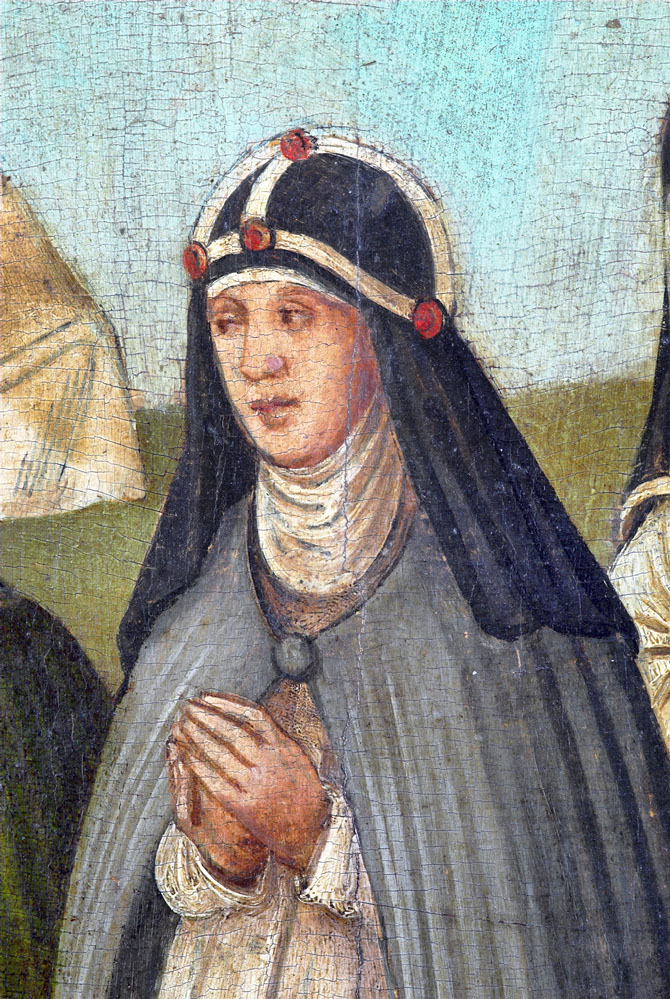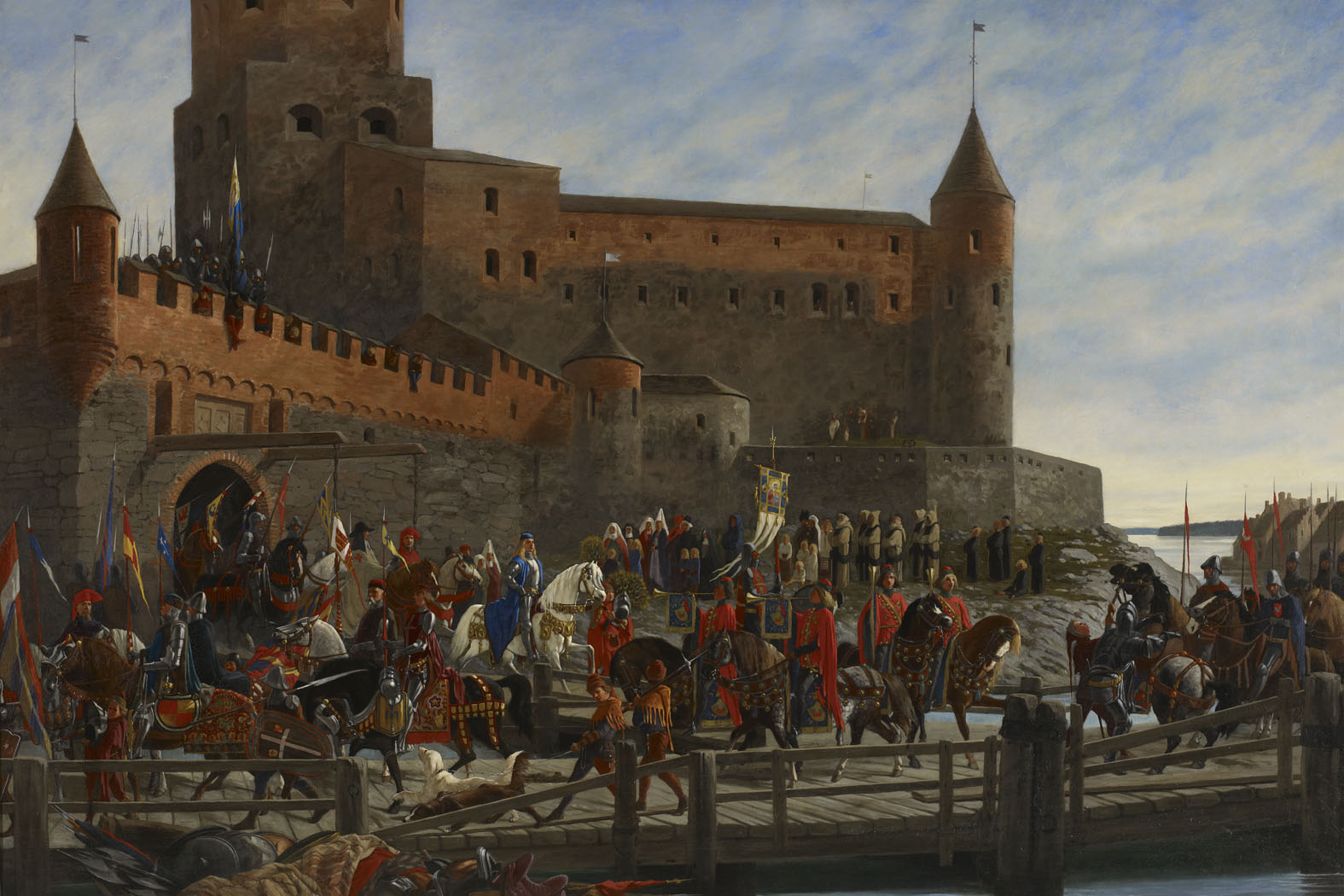|
Vadstena Monastery
The Abbey Pax Mariae ( la, Monasterium sanctarum Mariæ Virgìnis et Brigidæ in Vatzstena), more commonly referred to as Vadstena Abbey, situated on Lake Vättern in the Diocese of Linköping, Sweden, was the motherhouse of the Bridgettine Order. The abbey started on one of the farms donated to it by the king, but the town of Vadstena grew up around it. It was active from 1346 until 1595. History Foundation and duration The abbey was founded in 1346 by Saint Bridget with the assistance of King Magnus IV of Sweden and his Queen Blanche, who made a will donating ten farms, including that of Vadstena in Dal Hundred, Östergötland, to the abbey founded by Bridget. The daughter of Saint Bridget, Saint Catherine, on arriving there in 1374 with the relics of her mother, found only a few novices under a Religious Superior. They chose Catherine as their abbess. She died in 1381, and it was not until 1384 that the abbey was blessed by the Bishop of Linköping. The first recognized ... [...More Info...] [...Related Items...] OR: [Wikipedia] [Google] [Baidu] |
Bridgettines
The Bridgettines, or Birgittines, formally known as the Order of the Most Holy Savior (; abbreviated OSsS), is a monastic religious order of the Catholic Church founded by Saint Birgitta or Bridget of Sweden in 1344, and approved by Pope Urban V in 1370. They follow the Rule of Saint Augustine. There are today several different branches of Bridgettines. History The first monastery of the order was founded in 1369 at the former royal castle of Vadstena. St. Bridget's granddaughter, Lady Ingegerd Knutsdotter, was Abbess of Vadstena from 1385 to 1403. Upon her death on 14 September 1412, direct descent from St. Bridget became extinct. This opened the medieval concept of "Bridget's spiritual children", members of the order founded by her, to be her true heirs. The order spread widely in Sweden and Norway, and played a remarkable part in promoting culture and literature in Scandinavia; to this is to be attributed the fact that the motherhouse at Vadstena, by Lake Vättern, was not ... [...More Info...] [...Related Items...] OR: [Wikipedia] [Google] [Baidu] |
Bishop Of Linköping
Bishops of the Diocese of Linköping, Sweden. Before the reformation * Herbert (bishop), Herbert? * Rikard (bishop), Rikard? * 1139–1160s Gisle (bishop), Gisle * 1170–1171 Stenar (bishop), Stenar * 1187–1195/96 Kol (bishop), Kol * Johannes (bishop), Johannes? * 1216–1220 Karl Magnusson * 1220–1236 Bengt Magnusson * 1236–1258 Lars (bishop), Lars * 1258–1283 Henrik (bishop), Henrik * 1258–1286 Bo (bishop), Bo * 1286–1291 Bengt Birgersson * 1292–1307 Lars II (bishop), Lars * 1307–1338 Karl Bååt * 1342–1351 Petrus Torkilsson * 1352–1372 Nils Markusson * 1373–1374 Gottskalk Falkdal * 1375–1391 Nils Hermansson * 1391–1436 Knut Bosson * 1436–1440 ? * 1441–1458 Nils König * 1459–1465 Kettil Karlsson (Vasa) * 1465–1500 Henrik Tidemansson * 1501–1512 Hemming Gadh * 1513–1527 Hans Brask After the reformation * 1529–1540 Jöns Månsson * 1543–1558 Nicolaus Canuti * 1558–1569 Erik Falck * 1569–1580 Martinus Olai Gestricus * 1583–1587 ... [...More Info...] [...Related Items...] OR: [Wikipedia] [Google] [Baidu] |
Margareta Clausdotter
Margareta Clausdotter (died 10 December 1486) was a Swedish writer and genealogist, a Roman Catholic nun of the Bridgettine order and from 1473 until her death, abbess of the Vadstena Abbey. Christina Brask Christina Hansadotter Brask, or ''Christin Hansadotter'' (1459 – 5 March 1520), was a Swedish writer and translator, and a member of the Bridgettine Order in Vadstena Abbey. Biography Christina Hansadotter became a nun at Vadstena Abbey in 1473. ... translated the Antiphonarium for her.Liedgren, Jan"Margareta Clausdotter" Svenskt biografiskt lexikon She is best known for the chronicle she authored on the family of Saint Bridget, which includes some legends and stories not known from any other sources. Her chronicle influenced later historical and genealogical writers. One story, about ''"Bengt Lagman"'', the king's brother who marries a woman of humbler origins, ''"Sigrid the Beautiful"'', has been most famously retold in the play ''Bröllopet på Ulfåsa'' (1865) by ... [...More Info...] [...Related Items...] OR: [Wikipedia] [Google] [Baidu] |
Svenska Fornskriftsällskapet
Swedish or ' may refer to: Anything from or related to Sweden, a country in Northern Europe. Or, specifically: * Swedish language, a North Germanic language spoken primarily in Sweden and Finland ** Swedish alphabet, the official alphabet used by the Swedish language * Swedish people or Swedes, persons with a Swedish ancestral or ethnic identity ** A national or citizen of Sweden, see demographics of Sweden ** Culture of Sweden * Swedish cuisine See also * * Swedish Church (other) * Swedish Institute (other) * Swedish invasion (other) * Swedish Open (other) Swedish Open is a tennis tournament. Swedish Open may also refer to: *Swedish Open (badminton) * Swedish Open (table tennis) *Swedish Open (squash) *Swedish Open (darts) The Swedish Open is a darts tournament established in 1969, held in Malm� ... {{disambig Language and nationality disambiguation pages ... [...More Info...] [...Related Items...] OR: [Wikipedia] [Google] [Baidu] |
Bible
The Bible (from Koine Greek , , 'the books') is a collection of religious texts or scriptures that are held to be sacred in Christianity, Judaism, Samaritanism, and many other religions. The Bible is an anthologya compilation of texts of a variety of forms originally written in Hebrew, Aramaic, and Koine Greek. These texts include instructions, stories, poetry, and prophecies, among other genres. The collection of materials that are accepted as part of the Bible by a particular religious tradition or community is called a biblical canon. Believers in the Bible generally consider it to be a product of divine inspiration, but the way they understand what that means and interpret the text can vary. The religious texts were compiled by different religious communities into various official collections. The earliest contained the first five books of the Bible. It is called the Torah in Hebrew and the Pentateuch (meaning ''five books'') in Greek; the second oldest part was a coll ... [...More Info...] [...Related Items...] OR: [Wikipedia] [Google] [Baidu] |
Charles VIII Of Sweden
Charles VIII ( sv, Karl; 1408–1470), contemporaneously known as Charles II and called Charles I in Norwegian context, was king of Sweden (1448–1457, 1464–1465 and 1467–1470) and king of Norway (1449–1450). Regnal name Charles was the second Swedish king by the name of Charles (Karl). ''Charles VIII'' is a posthumous invention, counting backwards from Charles IX (r. 1604–1611) who adopted his numeral according to a fictitious history of Sweden. Six others before Charles VII are unknown to any sources before Johannes Magnus's 16th century book ', and are considered his invention. Charles was the first Swedish monarch of the name to actually use a regnal number as ''Charles II'' (later retrospectively renumbered VIII), on his wife's tombstone (1451) at Vadstena. Early life Karl Knutsson was born in October 1408 or 1409, at Ekholmen Castle, the son of Knut Tordsson (Bonde), knight and member of the privy council (''riksråd''), and Margareta Karlsdotter (Sparre av To ... [...More Info...] [...Related Items...] OR: [Wikipedia] [Google] [Baidu] |
Catherine Of Bjurum
Catherine Karlsdotter, in Swedish called ''Katarina Karlsdotter'' and later ''Katarina Gumsehuvud'' (died 7 September 1450) was Queen of Sweden from 1448 to 1450 and Queen of Norway from 1449 to 1450 as the second wife of Charles VIII / I. Biography Catherine was the daughter of the nobleman Karl Ormsson (Gumsehuvud). She married the Regent (and then widower) Charles on 5 October 1438, when she became first lady and functioned as Queen in a ceremonial sense until 1440, when her husband was replaced as regent. Before their marriage, dispensation was obtained from the Pope, as Catherine was related to Charles's first wife. This was to ensure that children born in the marriage would be regarded as legitimate. In 1448, her spouse became regent again and then was crowned King. She was crowned Queen of Sweden in Uppsala Cathedral on 2 July 1448. The next year, her husband became King of Norway also, making her Queen of Norway. The marriage is described as very happy and resulted in n ... [...More Info...] [...Related Items...] OR: [Wikipedia] [Google] [Baidu] |
Philippa Of England
Philippa of England (mid-1394 – 5 January 1430), also known as Philippa of Lancaster, was Queen of Denmark, Norway and Sweden from 1406 to 1430 by marriage to King Eric of the Kalmar Union. She was the daughter of King Henry IV of England by his first spouse Mary de Bohun and the younger sister of King Henry V. Queen Philippa participated significantly in state affairs during the reign of her spouse, and served as regent of Denmark from 1423 to 1425. Biography Early life Philippa was born to Henry Bolingbroke and Mary de Bohun, at Peterborough Castle, Peterborough. Her father became king in 1399. She is mentioned a couple of times during her childhood: in 1403, she was present at her widowed father's wedding to Joan of Navarre, and the same year, she made a pilgrimage to Canterbury. She mainly lived at Berkhamsted Castle and Windsor Castle. Marriage In 1400 or 1401, King Henry suggested to Queen Margaret I of Denmark, Norway and Sweden that an alliance be formed between Eng ... [...More Info...] [...Related Items...] OR: [Wikipedia] [Google] [Baidu] |
Margaret I Of Denmark
Margaret I ( da, Margrete Valdemarsdatter; March 1353 – 28 October 1412) was ruler of Denmark, Norway, and Sweden (which included Finland) from the late 1380s until her death, and the founder of the Kalmar Union that joined the Scandinavian kingdoms together for over a century. She had been Norway's queen consort 1363–1380 and Sweden's 1363–1364, since then titled ''Queen''. Margaret was known as a wise, energetic and capable leader, who governed with "farsighted tact and caution," earning the nickname "Semiramis of the North". She was derisively called "King Breechless", one of several derogatory nicknames invented by her rival Albert of Mecklenburg, but was also known by her subjects as "Lady King", which became widely used in recognition of her capabilities. Knut Gjerset calls her "the first great ruling queen in European history." The youngest daughter of King Valdemar IV of Denmark, Margaret was born at Søborg Castle. She was a practical, patient administrator and d ... [...More Info...] [...Related Items...] OR: [Wikipedia] [Google] [Baidu] |
Eric Of Pomerania
Eric of Pomerania (1381 or 1382 – 24 September 1459) was the ruler of the Kalmar Union from 1396 until 1439, succeeding his grandaunt, Queen Margaret I. He is known as Eric III as King of Norway (1389–1442), Eric VII as King of Denmark (1396–1439) and has been called Eric XIII as King of Sweden (1396–1434, 1436–39). Later, in all three countries he became more commonly known as ''Erik av Pommern'' (Eric of Pomerania), a pejorative intended to point out that he belonged elsewhere. Eric was ultimately deposed from all three kingdoms of the union, but in 1449 he inherited one of the partitions of the Duchy of Pomerania and ruled it as duke until his death in 1459. Succession background Eric was born in either 1381 or 1382 in Darłowo, Pomerania (Poland). Born Bogusław, Eric was the son of Wartislaw VII, Duke of Pomerania, and Maria of Mecklenburg-Schwerin. Margaret I, who ruled the kingdoms of Denmark, Norway, and Sweden, wanted her realm to be unified and peaceful and m ... [...More Info...] [...Related Items...] OR: [Wikipedia] [Google] [Baidu] |

.jpg)

_grave_2009.jpg)

.png)
